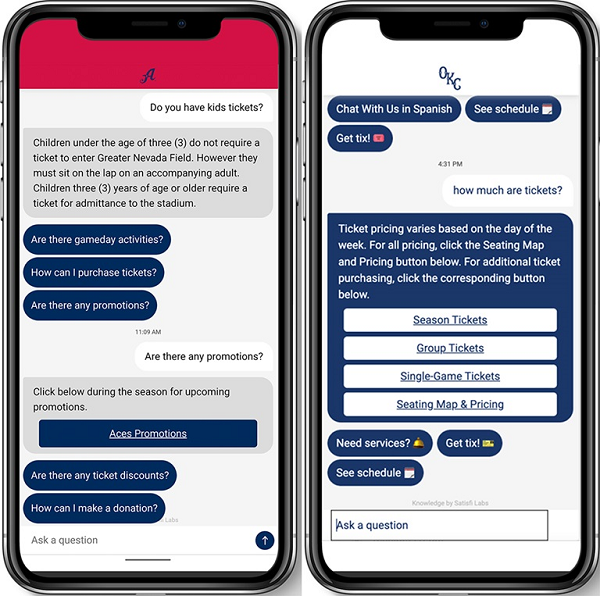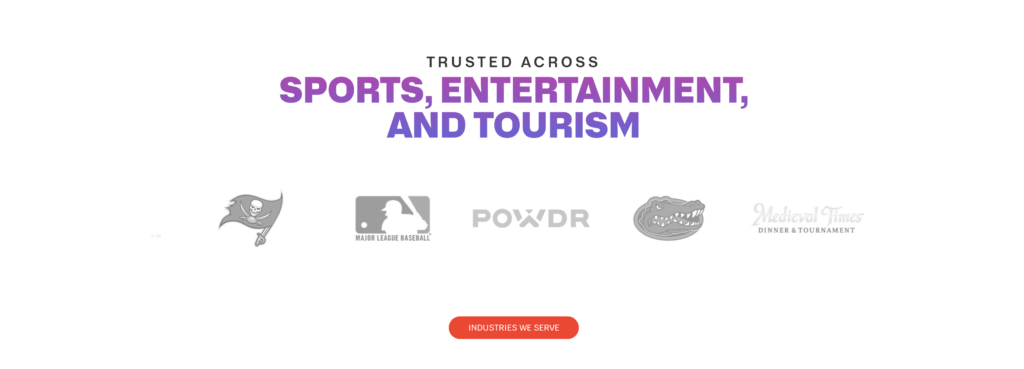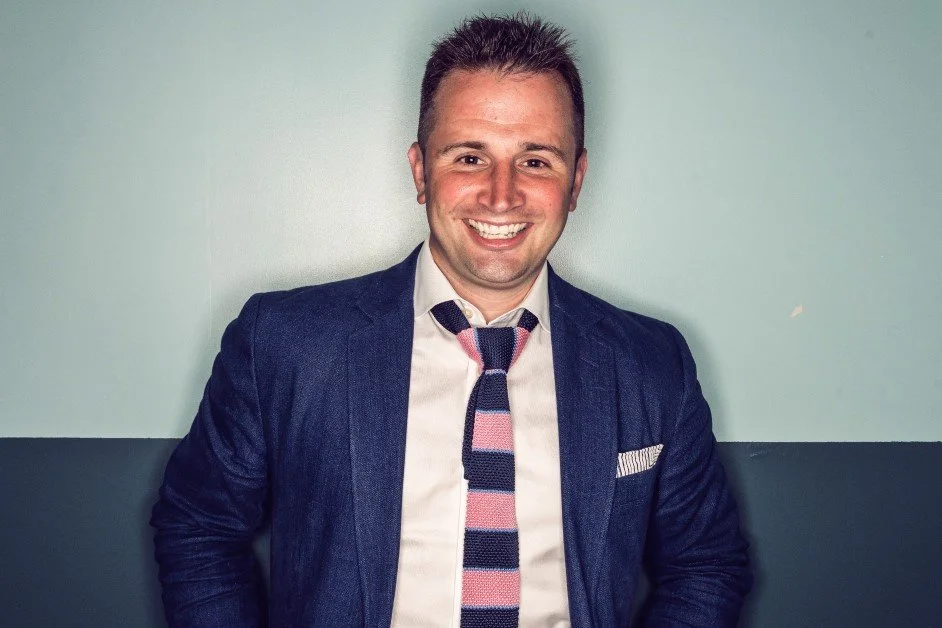Everybody is talking about AI these days.
But some people have been behind the scenes building it for years.
Don White is one of them.
Since 2016, Satifi Labs has been unlocking the power of proprietary brand data to answer customer questions on-demand in manners not found elsewhere.
In other words, they’re leveraging technology to reimagine how fans interact with sports teams.
Over the years they’ve partnered with leagues such as the MLB, NFL, NBA, NHL, MLS, and MiLB, to help them save staff hours, maintain brand consistency, collect unique customer data, and enhance the fan experience.
In this interview with Don White, we discuss how the company has evolved, some key lessons he’s learned over the past 8 years building an artificial intelligence platform, his thoughts on the future of artificial intelligence, and lastly advice around startup fundraising.
Hello, who are you and what is the name of your company?
My name is Don White and I am the CEO and co-founder of Satisfi Labs, an AI-powered Customer Experience platform for sports, entertainment, and tourism.
I started my career as a receptionist at Bloomberg during my junior year of college and was determined to climb the corporate ladder.
I ended up spending 15 years at Bloomberg, taking on various roles including managing the tech support department, becoming the head of product for equity trading, and eventually getting promoted to the Head of Sales for the Americas in the trading division.
When I was ready to leave sales in 2013, I started interviewing at startups and stumbled across one I wanted to work for.
Unfortunately, I didn’t get the job, and the co-founders ultimately told me they didn’t know if I was good, or if Bloomberg was good.
After putting in that much time and effort to build what I felt was a successful career, hearing that comment devastated me and stuck with me for a very long time.
Wanting to achieve something bigger, I decided to take a position as VP of Sales at startup, Datahug (now SAP). Datahug was an absolute blast and I still love all the people that I worked with. Adjusting from a huge corporate goliath to a company just launching its U.S. operation was something I surely needed to round out my experience.
Shortly after, I was recruited by a group of investors that were keen on disrupting Yelp. After extensive discussions and deliberation, we finally aligned on a new vision.
After that, I co-founded Satisfi Labs with Randy Newman and those same investors.
In essence, Satisfi Labs was created with one simple idea in mind: how can we make AI hirable?
In 2016, well before the current explosion of AI systems being utilized across the business community, we wanted to create a sort of “Amazon Experience,” specifically for stadiums and live events to make them searchable and shippable.
Our product works by unlocking the power of proprietary brand data to answer customer questions on-demand in manners not found elsewhere.
By partnering with several teams across the MLB, NFL, NBA, NHL, MLS, and MiLB, we are actively helping sports organizations save staff hours, maintain brand consistency, collect unique customer data, and enhance the fan experience.
What was the process of getting the company off the ground?
We saw an opportunity to enable search for locations and ultimately wanted to build something from the bottom up. It was built out of necessity.
As our origin story goes, we were planning to go to a Mets game and Randy Newman, our current CTO and Co-founder of Satisfi Labs, looked up the food items available at Citi Field.
As we sat in our WeWork office, Randy asked, “Hey, do you know they have bacon on a stick there?” I didn’t know that existed there – all I knew was that I wanted it and it got me wondering how many people who go to a game, especially first-timers, know what’s available to them.
This led to us pitching an idea to the Mets to create a mobile web page that could be dropped into any app or launched from a QR code so a customer could interact with our location-specific Q&A experience.
We added a suggested question at the top for a Mets fan who was coming to a game at Citi Field: “Where can I get bacon on a stick?” The answer was a great explanation of a location and how to get there from their seat.
We ended up seeing everything we needed to understand how we could bring AI and real-time answers to sports and adjacent industries.

How is the company doing today and what does the future look like?
Our company has grown consistently since inception, even during the pandemic, when we faced tremendous headwinds and many clients suffered tremendous losses and canceled events.
We managed to not only maintain but also find some ability to expand our business. We have extremely high retention because we invest a lot of our time and people into our customers, and are very responsive to their needs.
We have a saying that we are “built by the industry for the industry” because small things like enabling live chat on mobile devices, having a specific method to create the most robust food and beverage finder, and offering ticketing integrations to make conversions easier all come from client ideas and our ability to deliver on them.
Historically we haven’t raised a lot of money because we operate a cash-focused business where we want business operations to fund our day-to-day growth.
We’ve acquired over 90 million unique data points in our AI model across 500+ customers and can continue to provide a strong environment to our employees, our customers, and our investors.
We’ve seen a return on investments ranging from 200 to 800% because our platform provides real cost savings on labor, revenue attribution, and unique data acquisition for our clients.
Through starting the business have you learned anything particularly helpful or advantageous?
The biggest lesson I have learned from being in the AI business for nearly a decade is quite counterintuitive. To put it simply, people are everything.
This goes back to the first client you acquire – will they partner with you or be difficult to work with? Your first few hires are also important because to build the right culture, you have to start with a core group that not only believes in the vision but has the talent and ability to wear many hats.
I’ve made plenty of mistakes hiring people I thought would be a great fit based on their resume or experience.
At the end of the day, a vast majority of our team comes from internships, former partners, or customers turned into employees. When you run into an unthinkable and uncontrollable situation like COVID, your people are all you have. There have probably been times we could have grown a bit more in revenue if we hired differently or recognized development issues more quickly.
That said, I can point to more cases where cutting people too quickly would have been a bigger mistake.
Although we are a collection of misfits with unconventional backgrounds, the grit and shared commitment from our people is what makes me excited to come to work every day.

What advice do you have for founders looking to raise capital?
Raising capital is not fun.
It reminds me of the times I went to school knowing I had a test that day and because of that, my whole mindset shifted my experience.
Even though my friends were there or I had plans after that test, it made me dread going to school. Fundraising is like going to school and having a test every day, but the questions are different even though the subject is kind of the same, and there are no right answers because each teacher grades differently.
My best advice is to stay true to yourself, be passionate about what you believe the right direction and approach is, and always maintain detail in your data to support why you feel a certain way.
As I look back on my own mistakes, there were probably times I should have been more aggressive in asking for more money but I was always very conservative in my approach, taking only what I knew I could use and how I could use it.
That meant we were forced to operate very cost-efficiently and burn was always the enemy.
That is not to say that we don’t burn cash during growth periods or think companies that do burn cash are any less than us, but considering Randy and I are East Coast finance career people, for us, cash is King. And cash doesn’t mean raising it, it means earning it through revenue and business operations.
What are some predictions you have for the industry over the next year?
First, the concept of private Large Language Models (LLMs) is poised to gain significant traction.
This trend signifies the emergence of an industry focused on creating bespoke LLMs tailored to specific sector needs depending on the industry, where accuracy and data sensitivity are paramount.
Tech giants like Microsoft and Google are expected to lead this charge, leveraging their vast computing infrastructures. This development is not just about creating these models.
It’s also about the ecosystem that will grow around them and the tools and services necessary to facilitate the adoption of private LLMs in various industries so other industries will eventually be able to build their own LLMs.
Conversational AI is also set to transform.
We’ll witness an increase in interactions where chatbots communicate with each other, leveraging a network of specialized knowledge.
This will greatly enhance the accessibility and breadth of information available through conversational interfaces. Imagine a scenario where one chatbot, recognizing its limitations, seamlessly connects to another with expertise in a specific area, thereby providing a richer, more informed response to the user.
Lastly, the demand for trusted data sources will intensify.
This push is crucial for brands aiming to be the authoritative voice on their products and services and for end-users who seek reliable, verified information from their AI interactions. This trend highlights the growing importance of credibility and accuracy in the age of information overload.

Are there any particular tools, software, or resources you use to be more productive?
Since we’re a remote company, Slack is probably the most pivotal communication software. It connects everyone and is more efficient than email.
Second, I am conducting this interview through voice dictation software because I had a traumatic shoulder injury, and I have not had full usage of the upper left side of my body for several weeks due to an accident.
I’ve found that talking to communication software like Slack or Gmail is quite therapeutic, and it adds a layer to my personal communication style.
Sometimes hearing the sound of your voice as you communicate something will shift how you speak to someone. In this remote age, it feels like an efficient and personal method we should all adopt.
Even once my shoulder fully heals, and I can type quickly again, I still will use this software often so I can improve the way I communicate with employees I don’t see face-to-face every day.
What advice do you have for founders trying to build a team and hire talent?
Company culture is a paramount area of focus at Satsifi Labs and should be a top priority for any growing business. I truly believe in servant leadership, as I would never ask any employee to do something that I have not done in the past or would be willing to do today.
If you are a young company, the CEO needs to get in the weeds with staff members when everyone is all hands on deck. As an executive, there are undoubtedly times when you will need to make difficult decisions regarding the future of employees.
Maintaining a level of respect among members of staff is crucial to creating a healthy culture in your office. If a CEO truly cares about the lives and well-being of their staff, they will always make decisions that position the company for success.
Are there any books & podcasts you recommend?
Measure What Matters by John Doer, The Innovator’s Dilemma by Clayton M. Christensen, Predictable Revenue by Aaron Ross & Marylou Tyler, Raving Fans by Ken Blanchard Sheldon Bowles.
Are you currently hiring and if so, where can people apply and find out more?
We’ve just completed a group of new hires in Q4 of 2023 and will look to be adding to our team in the summer of 2024. Our website posts all opportunities that are currently available.

